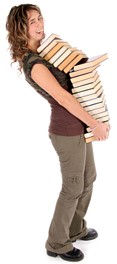Types of Cleaning Cloths
There are a variety of cleaning cloths used around the household—some made for special tasks and others more general, and some repurposed from other uses.
Rag Cloths
Where do old tee-shirts go when they are worn out? In many homes they join remnants of flannel shirts and nightgowns, and worn out towels in a rag bag. Filled with clean cloths of various descriptions and sizes and colors, the rag bag gives a ready supply of cleaning cloths for a wide variety of purposes: dusting, mopping up spills, and dealing with messes that you want to clean up without minding that you may have to throw away the cleaning cloth.
Washcloths
Also known as facecloths or washrags, washcloths are generally square cloths made for washing a person’s face and/or body. They can be made of a variety of fibers, including cotton (including organic cotton), ramie, silk, synthetic blends, cotton-polyester blends, and microfiber. At least one recent study has shown that how a washcloth feels and how well it cleans are not necessarily related.
Washcloths may have a single or double layer of material. They can use a variety of weaves, including fleece, thermal, jersey, and terry. They may or may not have a bound edge, and their dimensions vary from 9” x 9” (23 cm x 23 cm) for babies to 13” x 13” (33 cm x 33 cm) for adults.
Some washcloths have a place for inserting soap in some form, so that the cleaning agent and the washing cloth are combined.
Baby Wipes
Made of non-woven fabric, these disposable towelettes are specially treated to be durable and gentle. They are packaged to retain moisture, allowing cleaning of babies’ diaper area and other health care needs when no access to water, soap, and towel is possible or practical. When marketed for adults, they may be called personal cleansing wipes or pre-moistened cleaning wipes. They are made to dispense one sheet at a time, and should never be flushed in a toilet. Some are scented, while others are marketed as being variously:

- • alcohol-free
• hypoallergenic
• unscented
• pH-balanced
• treated with aloe vera
They are available in tubs, small travel packs, and in refill packs to restock an existing tub.
Kitchen Cleaning Cloths
• Terry cloth—Quite useful for blotting up stains is terry cloth, a cotton cloth with innumerable loops that make it very absorbent. Old towels and bathrobes may provide you with a supply of this type of cleaning cloths.
• Microfiber—Made of woven synthetic fiber has tiny loops that function differently than the loops on terry cloth: these loops trap dirt. They may be used dry or wet, and their cleaning power may obviate the need for a cleaning solution. (In the kitchen, of course, a cleaning solution should often be used to prevent food-borne illness.) Microfiber cleaning cloths come in a variety of sizes and weights to address different cleaning needs, from delicate to rough and tough.
• Polishing Cloths—When it’s time to clean the silver or polish the brass, the soft cloths sold as polishing cloths will help protect the item being polished and evenly distribute the polish. Pure cotton flannel from the ragbag may substitute.
One special type of polishing cloth that’s very good for wiping fingerprints off of metal, such as fine knives made with high carbon steel (albeit, used more often on automobiles than in the kitchen) is the chamois (pronounced SHAM-ee), which is a natural product made of the skin of a small antelope, sometimes substituted by sheepskin. There are also a synthetic versions available.
Written by Mary Elizabeth
